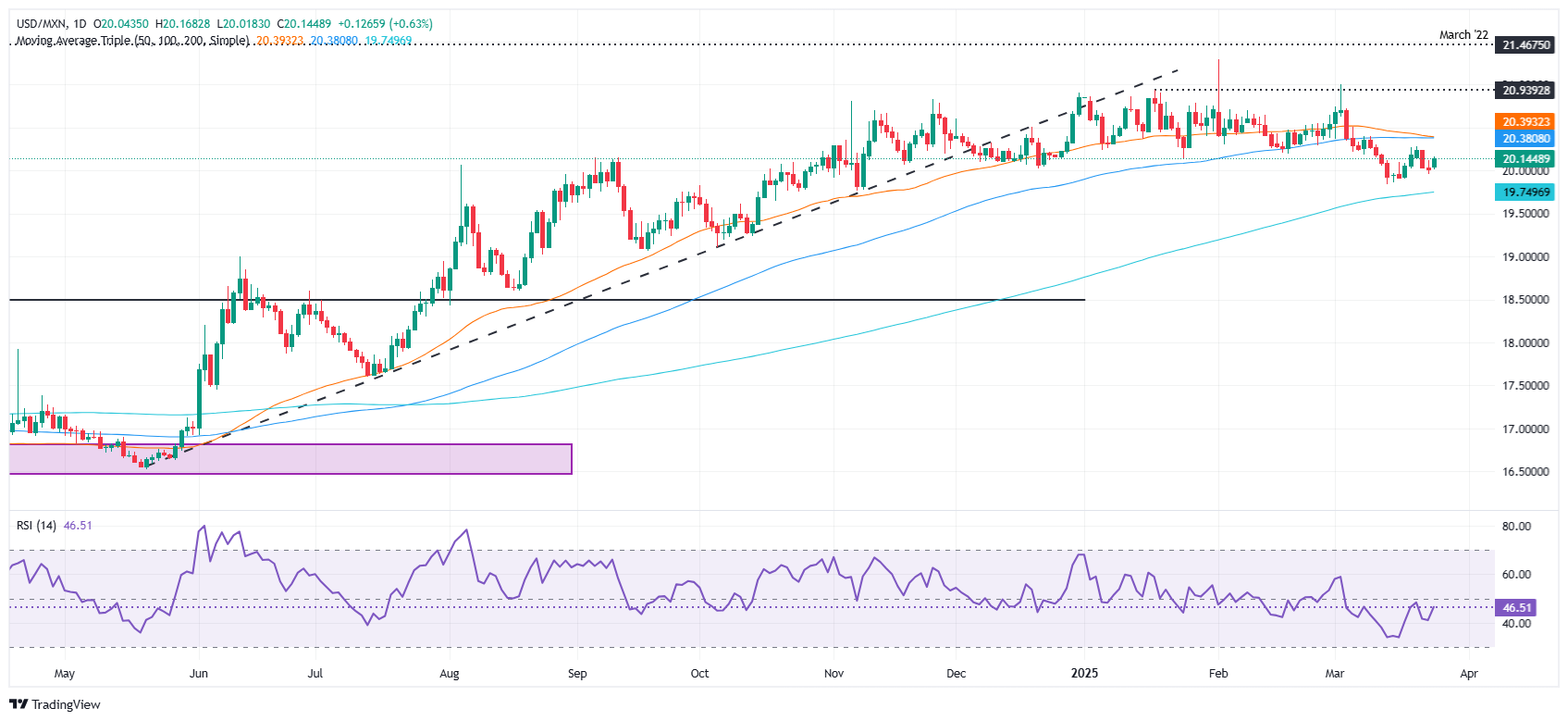Mexican Peso dips as markets focus on potential Banxico rate cut

- The Mexican Peso falls as traders brace for a 50-basis-point rate cut amid signs of cooling inflation and weak economic activity.
- Banxico expected to slash rates by 50 bps as economy shows signs of fatigue.
- Economic activity remains in contraction despite solid retail sales and marginal January improvement.
The Mexican Peso (MXN) depreciates against the US Dollar (USD) during the North American session on Wednesday following the release of economic data during the week, which highlighted the evolution of the disinflation process as well as an economy that is weakening. The USD/MXN trades at 20.08, up 0.20%.
Traders are bracing for Banco de Mexico’s (Banxico) monetary policy decision on Thursday. The central bank is expected to reduce rates by 50 basis points (bps) from 9.50% to 9% due to the evolution of the disinflation process and signs that the economy is slowing down.
This week, Mexico’s economic schedule revealed that Economic Activity in January improved compared to December but remained in contractionary territory for the second consecutive month. Meanwhile, inflation data was positive as the first-half inflation in March dropped in both headline and core readings, an indication of the evolution of the disinflation process.
Other data showed that Retail Sales in January were solid, exceeding the previous month’s reading and forecasts, but it is the first solid reading since April 2024, as sales shrank during the last eight straight months.
Given the backdrop, further upside is seen in USD/MXN. However, if US President Donald Trump makes tariff exemptions to Mexico, the outlook for the economy could improve. Hence, the Peso could strengthen and exert downward pressure on the exotic pair.
Ahead this week, Mexico’s docket will feature the Balance of Trade and Banxico’s interest rate decision. Across the border, the US schedule will feature the release of the Fed’s preferred inflation gauge, the core Personal Consumption Expenditures (PCE) Price Index.
Daily digest market movers: Mexican Peso drops ahead of Banxico’s meeting
- The Citi Expectations Survey revealed that most private economists expect Banxico to reduce rates by 50 basis points. According to the survey, Mexico’s primary reference rate is expected to end 2025 at 8%, down from 8.25%.
- The same survey projects the USD/MXN to end at 20.98, down from 21.00 in the last poll.
- Inflation expectations remained anchored in the high 3% range, while GDP is foreseen expanding by 0.6%, down from 0.8% in the last survey.
- Traders had priced the Fed to ease policy by 64 basis points (bps) throughout the year, according to data from the Chicago Board of Trade.
USD/MXN technical outlook: Mexican Peso loses traction as USD/MXN rises past 20.10
USD/MXN remains upwardly biased. Although it has refreshed a two-day high at 20.16, it fell below 20.10, paving the way for further downside. The Relative Strength Index (RSI) shows that momentum does not support either buyers or sellers, hinting at choppy trading conditions.
That said, the first key support would be the 20.00 figure. If hurdled, the next support would be the 200-day Simple Moving Average (SMA) at 19.71, followed by the September 18 swing low of 19.06. On the other hand, if USD/MXN bulls clear the 20.20 mark, the exotic pair would be poised to test the confluence of the 100-day and 50-day SMAs at 20.22 and 20.38 each, ahead of the 20.50 area.
Tariffs FAQs
Tariffs are customs duties levied on certain merchandise imports or a category of products. Tariffs are designed to help local producers and manufacturers be more competitive in the market by providing a price advantage over similar goods that can be imported. Tariffs are widely used as tools of protectionism, along with trade barriers and import quotas.
Although tariffs and taxes both generate government revenue to fund public goods and services, they have several distinctions. Tariffs are prepaid at the port of entry, while taxes are paid at the time of purchase. Taxes are imposed on individual taxpayers and businesses, while tariffs are paid by importers.
There are two schools of thought among economists regarding the usage of tariffs. While some argue that tariffs are necessary to protect domestic industries and address trade imbalances, others see them as a harmful tool that could potentially drive prices higher over the long term and lead to a damaging trade war by encouraging tit-for-tat tariffs.
During the run-up to the presidential election in November 2024, Donald Trump made it clear that he intends to use tariffs to support the US economy and American producers. In 2024, Mexico, China and Canada accounted for 42% of total US imports. In this period, Mexico stood out as the top exporter with $466.6 billion, according to the US Census Bureau. Hence, Trump wants to focus on these three nations when imposing tariffs. He also plans to use the revenue generated through tariffs to lower personal income taxes.
